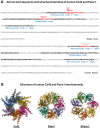Connexin 43 and Pannexin 1 hemichannels as endogenous regulators of innate immunity in sepsis
- PMID: 39763679
- PMCID: PMC11701031
- DOI: 10.3389/fimmu.2024.1523306
Connexin 43 and Pannexin 1 hemichannels as endogenous regulators of innate immunity in sepsis
Abstract
Sepsis is a life-threatening organ dysfunction resulting from a dysregulated host response to infections that is initiated by the body's innate immune system. Nearly a decade ago, we discovered that bacterial lipopolysaccharide (LPS) and serum amyloid A (SAA) upregulated Connexin 43 (Cx43) and Pannexin 1 (Panx1) hemichannels in macrophages. When overexpressed, these hemichannels contribute to sepsis pathogenesis by promoting ATP efflux, which intensifies the double-stranded RNA-activated protein kinase R (PKR)-dependent inflammasome activation, pyroptosis, and the release of pathogenic damage-associated molecular pattern (DAMP) molecules, such as HMGB1. Mimetic peptides targeting specific regions of Cx43 and Panx1 can distinctly modulate hemichannel activity in vitro, and diversely impact sepsis-induced lethality in vivo. Along with extensive supporting evidence from others, we now propose that hemichannel molecules play critical roles as endogenous regulators of innate immunity in sepsis.
Keywords: ATP; Connexin 43; HMGB1; Pannexin 1; hemichannel; inflammasome; innate immune cells; mimetic peptide.
Copyright © 2024 Li, Lou, Chen, Qiang, Zhu and Wang.
Conflict of interest statement
The authors declare that the research was conducted in the absence of any commercial or financial relationships that could be construed as a potential conflict of interest. The author(s) declared that they were an editorial board member of Frontiers, at the time of submission. This had no impact on the peer review process and the final decision.
Figures


References
-
- Tracey KJ, Fong Y, Hesse DG, Manogue KR, Lee AT, Kuo GC, et al. . Anti-cachectin/tnf monoclonal antibodies prevent septic shock during lethal bacteraemia. Nature. (1987) 330:662–4. - PubMed
-
- Alldred A. Etanercept in rheumatoid arthritis. Expert Opin Pharmacother. (2001) 2:1137–48. - PubMed
-
- Feldmann M, Maini RN. Anti-tnf alpha therapy of rheumatoid arthritis: what have we learned? Annu Rev Immunol. (2001) 19:163–96. - PubMed
Publication types
MeSH terms
Substances
Grants and funding
LinkOut - more resources
Full Text Sources
Medical

